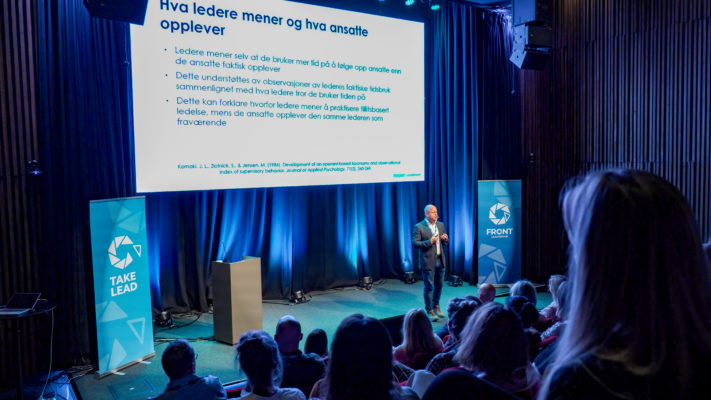One particular form of leadership development has a major impact on business profitability. This was the message of Professor Anders Dysvik, when he summarized what research says about leadership and leadership development at Norway's largest conference for leadership developers, TAKE LEAD, organized by FRONT Leadership in Barcode in Oslo.
Written by: Hedda Kise
The research is unequivocal: leadership development works very well and is highly profitable if you take into account some very special conditions. Professor Anders Dysvik from the Department of Management and Organization at BI Norwegian Business School explained what these are at the TAKE LEAD conference, and you can read a summary here.
Conditions for successful leadership development
Leadership development increases profitability
- "My clear message is that the right leadership development not only improves the well-being of employees, but it is also good for the reputation of the company and for the bottom line over time," said Anders Dysvik, Professor at the Department of Management and Organization at BI Norwegian Business School in his lecture.
The Norwegian professor is a pillar of evidence-based leadership development. He has been involved in a number of Norwegian and international research projects on management and leadership development, has over sixty publications in A-ranked international journals and has written books on profitability through human resources and productive motivation.
Greater returns
"Investing in motivated and loyal employees leads to additional returns for companies," said Dysvik, who presented several research projects that support this, including an analysis of Great Place to Work businesses.
Great Place to work is a ranking of companies in different countries, based on what management does in terms of leadership development, to strengthen and take care of human resources, in combination with a comprehensive employee survey.
Professor of Finance Alex Edmans examined the businesses on the list in the US for 27 years between 1984 and 2011 - and compared them to their competitors who were not on the list.
The listed Great place to work companies had 2.3 - 3.8 percent higher returns per year than their peers, controlling for a range of past returns and industry characteristics.
Even more important now
A later replication study, published in 2021, showed that during the financial crisis, the positive effects for Great Place to Work companies became even stronger.
- "There are many indications that in times of recession, job satisfaction is even more beneficial for company value and excess returns," Dysvik explains, referring to the trends from the pandemic.
Dysvik also led the large expert committee that prepared the Abelia report on future-oriented employers, which was published in 2021. The report concluded that organizations that are able to attract and retain competent employees have a clear tendency to have more productive employees, which ensures both a good reputation and profitability for the company
What matters
But what is it that increases job satisfaction so that companies don't lose talent and key people to competitors?
-"The manager-employee relationship is important, especially the immediate manager, i.e. the line manager, cannot be underestimated," Dysvik emphasized.
What matters is the everyday experience of being seen and being appreciated.
Therefore, look for the managers who do well on manager-employee relations in employee surveys. "It's not always the managers who promote themselves and who are keen to be seen by the organization that do best in manager-employee relations," Dysvik pointed out.
Research shows that the relationship with the immediate manager is by far the biggest reason why people leave their jobs.
Best effect
What matters most in terms of whether people stay in their jobs is what researchers call affective, or emotional, organizational commitment.
- "Managers must be developed to help employees feel a sense of pride, belonging and that they are part of the unit and department. The most important thing is the feeling that both the manager and the organization have a long-term perspective for the employee, as well as the feeling of being treated fairly," says Dysvik, who points out that one good thing that the pandemic brought with it was that more managers discovered that they can trust their employees.
You should focus on trust in the employee and work long-term. Perks and higher salaries are short-term solutions that don't have much effect," Dysvik advises.
Turnover
If you thought 5 percent annual turnover was okay, think again. Because research clearly shows that employees who have turnover thoughts work significantly less efficiently and perform worse at work.
"Many companies think it's okay to 'let off steam' with a 5 percent annual turnover rate. However, research shows that this is very unprofitable, because you end up with 5-10 percent of employees underperforming on a permanent basis," Dysvik warns.
Instead, it pays to train managers to make the right moves to ensure that employees are happy in their jobs and develop their full potential so that the business can make the most of their talent.
Don't single out talents
But Anders Dysvik warns against what he calls injudicious use of the concept of talent.
The research concludes that it is not good for business to identify a few as talents and then cultivate these few.
- This often creates unrealistic and inappropriate expectations among the 5-10 percent who are selected, while at the same time there can be a lot of disruptive noise among the 90-95 percent who are not called talents," says Dysvik about what he calls an exclusionary club.
The best thing you can do
If most employees are not supported to develop their talent and full potential, it is not very profitable for the business. There is a huge amount to be gained from developing the talent of the many, rather than the few. The best thing you can do is to have talent programs designed for this.
- "Talent programs should be open. Knowledge about the programs should be spread throughout the company and everyone must have the opportunity to apply," says Dysvik.
Candidates who are not offered a place in a development program must receive clear advice from their manager on what they can work on to get into position for the next round.
The worst thing you can do
The worst thing is when it is the managers themselves who select the talent. The research concludes that this becomes even more difficult and even more unfair.
- "Over 60 percent of the variations in manager-rated performance can be explained by whether the manager likes you or not, i.e. the tryne factor," Dysvik explains. Prejudice also prevents companies from exploiting their employees' full potential.
Many 60-year-olds are discriminated against when it comes to development paths and recruitment.
- Instead, try to think about how you can make the best possible use of the great experience they have," Dysvik advises.
- "The only thing that has been documented with increasing age is skepticism about change, but that can be a good thing if the basis for the skepticism is previous experience that the company could benefit from if they listened," Dysvik explains.
The right leadership development
In a society where the pace of change is increasing, employees and managers are not in the same location, and the world's knowledge doubles every 12 hours, most things have become confusing.
Leadership development can also be many things, so how do you go about finding the right way to develop leaders' relational skills and business acumen?
- "The research says that you shouldn't choose general leadership development programs, but rather conduct a thorough needs analysis and then tailor programs," says Dysvik. "What do managers need to get their employees to perform better than they thought possible? What do employees need to feel closer and more connected to the organization? Specifically, what are perceived as actual needs in all parts of the organization?
- "But be careful with extensive use of 360, because such anonymous employee surveys are less accurate when it comes to questions about career, salary and administrative matters," Dysvik warns. "360 can temporarily be useful for measuring development.
Practical training over time
Research shows that the best effect is achieved when a diversified set of learning activities is used, from information and teaching to practical training.
If time and resources are limited, practical everyday training is the most important thing," says Dysvik.
The research also shows that you should choose multiple sessions over time, rather than a single session once in a while.
- "Don't ask managers to carry out self-studies, because then there is a risk that it will become a salvage item for the individual manager in a busy working day," says Dysvik.
At the same time, research shows that leadership development programs work best when supported.
Don't go alternative
- "The most important thing is to ensure that the development programs used are evidence-based and practically relevant," says Dysvik, noting that, for example, there is no research evidence to suggest that a course in sensitivity training with horses or dance training with an educator at a seminar will make managers better leaders.
Nor is there any research evidence to suggest that such "leadership development" leads to increased employee satisfaction and/or better financial results for the company.
What has been proven to work is to increase managers' knowledge and understanding of work-related relationships between people - and to practice this over time.
Top management
But the most important thing, according to Dysvik, is that business knowledge is also included in the development programs, and that top management takes ownership of leadership development.
- "If senior management takes the lead by participating in development programs themselves, as well as talking up leadership development and thus signaling with both words and actions that this is important for the company's success and a priority for everyone, the company will be able to achieve very positive trickle-down effects," says Dysvik. "Strong signals from the top group provide guidelines for the rest of the organization and contribute to even more impact from leadership development.
Therefore, Dysvik welcomes an annual TAKE LEAD conference as a meeting place for senior managers and leadership developers, with interesting lectures and research-based presentations that are useful, both for senior management and the HR department, for the benefit of the future of Norwegian businesses.



